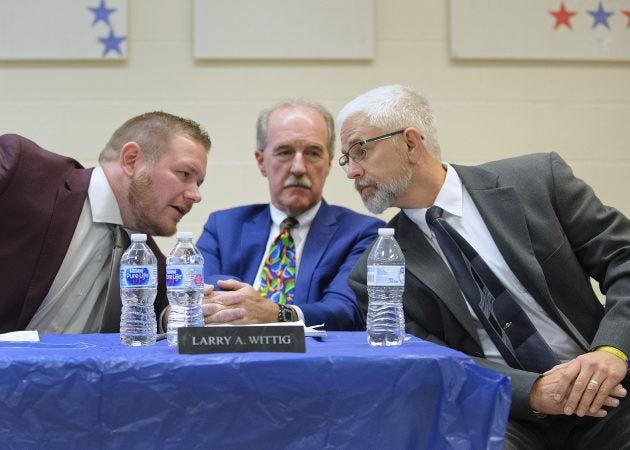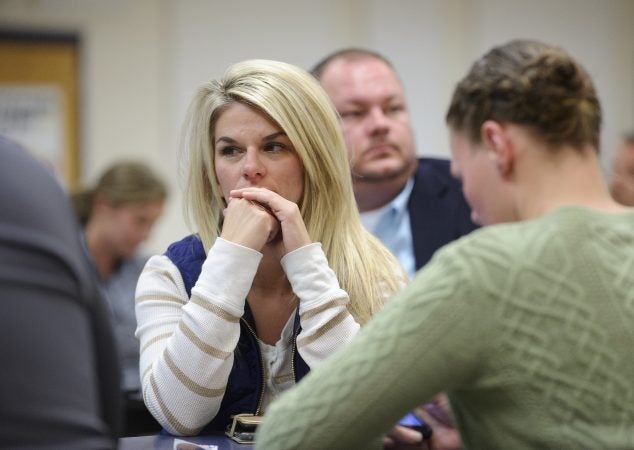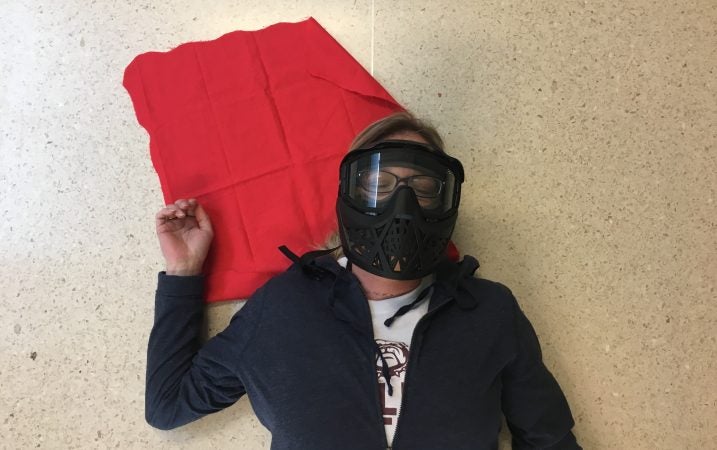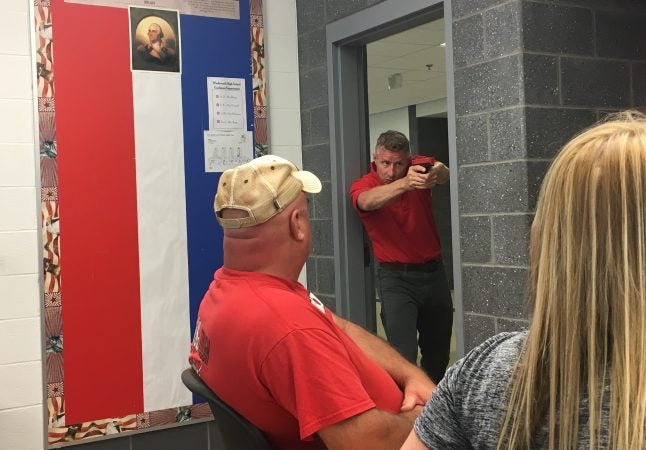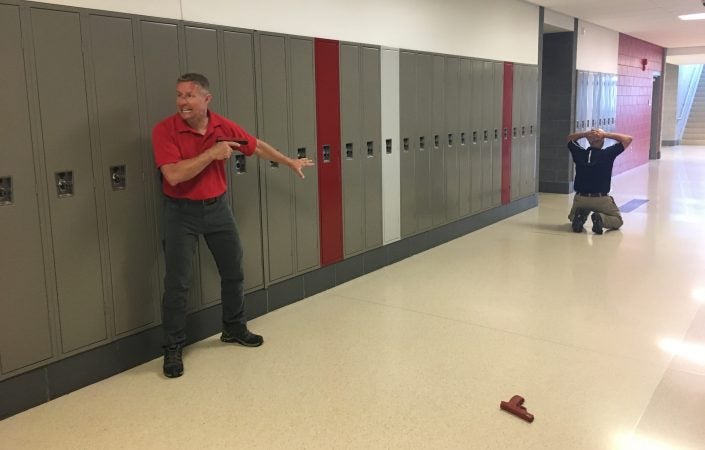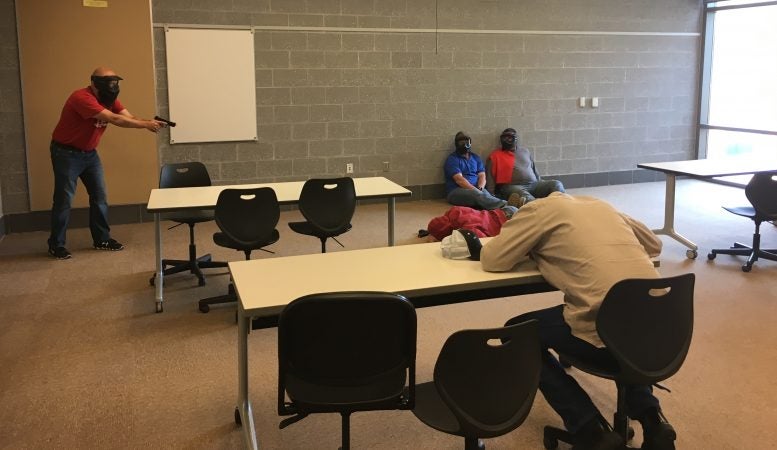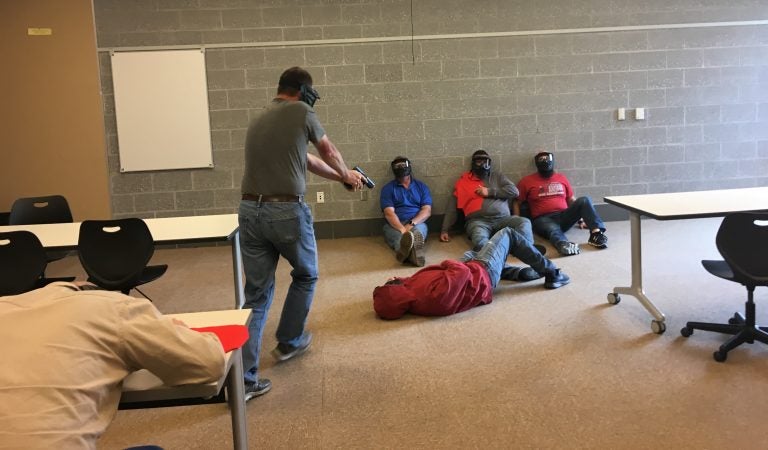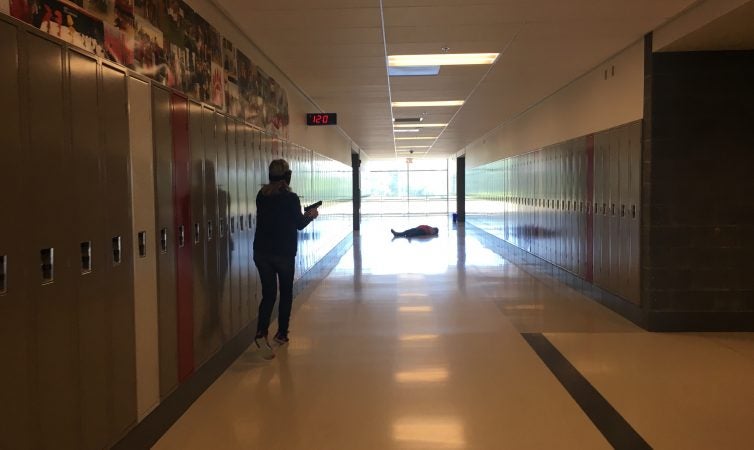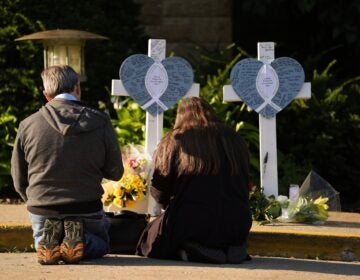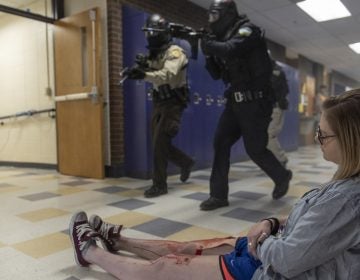‘Shooting people is deescalation’: Three days with teachers training to use guns in schools
The training provides a glimpse of how Pa. schools could change if armed teachers become a new normal in classrooms.
Andrew Blubagh is kneeling on the ground holding a handgun flat on his knee, its barrel pointed at the dirt berm that surrounds the firing range. Angie, a petite woman in her 40s, is beside him, her index finger wrapped around the trigger, his wrapped around hers. He wants Angie to feel how much force it takes to fire the weapon. He wants her to be prepared.
“You bring the gun up. Somebody comes around the corner. They’ve got something in their hand,” he says. “You bring the sights up to your line of sight.”
Blubagh, a police officer and firearms instructor, pulls Angie’s finger to the trigger’s point of resistance — the pressure wall.
“You give them verbal commands,” he continues. “You see it’s a knife, he brings it up. You fire a shot.”
Smoke rises from the barrel in the flat hot sunshine of the range, the scent of gunpowder and manure in the air.
“Fire another shot, he’s not going down. Fire another shot,” Blubagh presses Angie’s finger into the trigger, discharging bullet after bullet into the dirt.
“He is still moving, reaching for the knife again. You align the sights onto the head. You fire off another shot. Bam!”
He pulls the trigger once more. “He is dead.”
“Pressure wall,” “line of sight,” the feeling of a trigger giving way under her finger, the kick of the gun recoiling against her palm — all of these are new to Angie. In running shoes and tasteful earrings, dirty-blonde hair pulled up under a ballcap, she’s an eager student.
Until May, Angie had never touched a gun. Now, she’s in the middle of three days of target practice, firearms skills, and tactical training run by the group FASTER Saves Lives.
And soon, if everything goes to plan, the fifth grade English and science teacher will be carrying a gun in her Ohio classroom.
“I volunteered,” she said. “Our district has armed staff to protect our students, and I was asked to join the program, so I agreed.”
Arming teachers to prevent or lessen the death toll of mass shootings is a controversial proposition, and the training teachers receive before being authorized to carry guns in the classroom is one of the biggest sources of debate.
Before 17 students and staff were killed in a shooting at Marjory Stoneman Douglas High School in Parkland, Florida in 2018, about 250 school districts around the country allowed staff to carry guns. Since, according to a VICE News investigation, that number has nearly doubled, to at least 466. But, as VICE points out, getting an exact number is difficult — districts don’t always tell the public or state officials that they’ve armed their staff.
At Angie’s school, a third of the faculty already carry guns anonymously. The public knows that some teachers and administrators are carrying, but they don’t know who. Not even their unarmed colleagues are supposed to be in the loop.
“Teachers right beside me don’t know,” said Angie, who asked that we didn’t publish her surname or the name of her school. “So, it’s pretty covert.”
The students don’t know either. Armed colleagues have already taught Angie where to conceal her firearm, how to wear it so children can’t feel it when she hugs them.
“Cause we’re huggers,” she laughed. “You have to get them from this side, not this side. You have to retrain a lot of things that you do.”
***
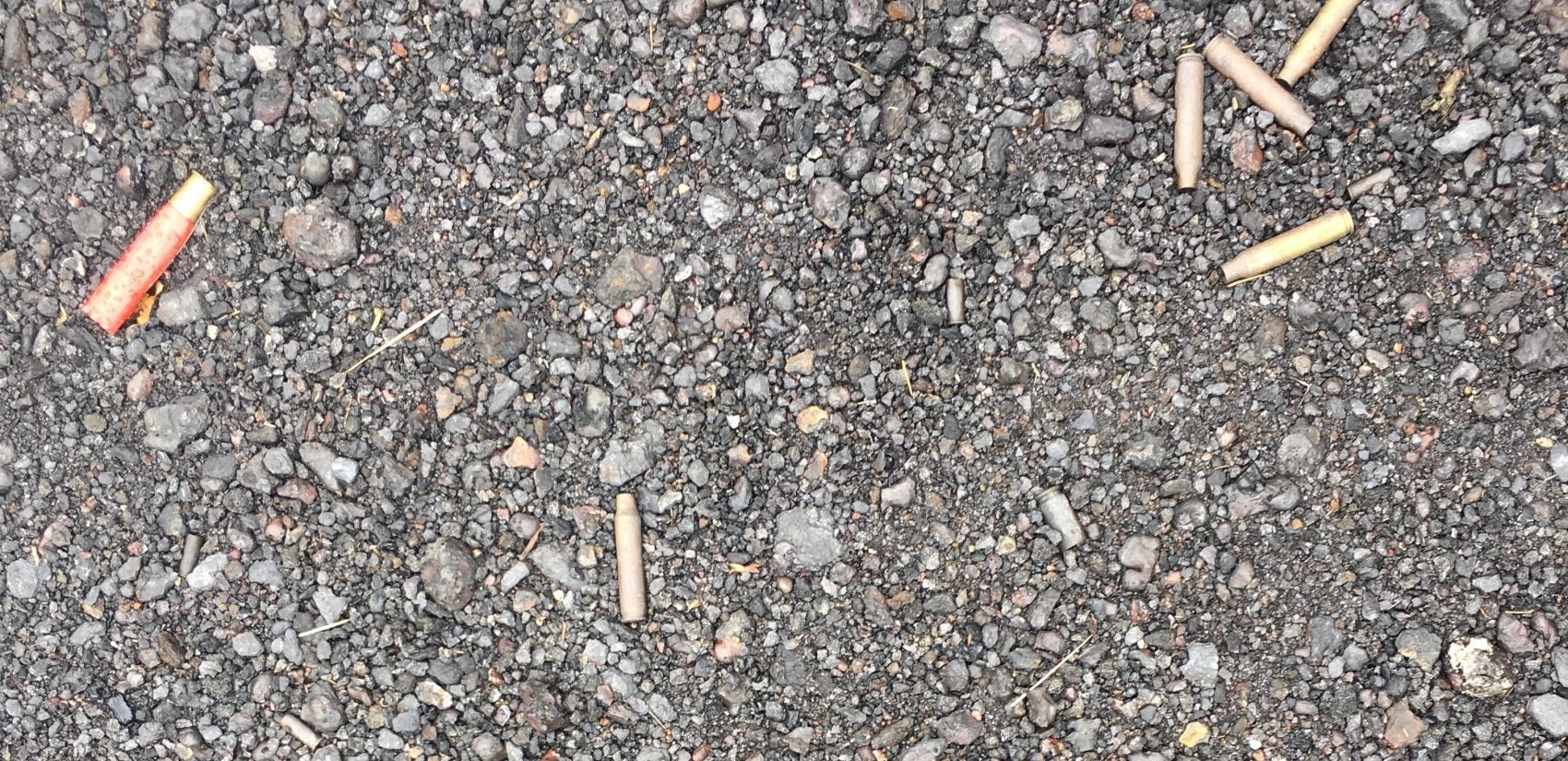
The pitch to Tamaqua
Last fall, Joe Eaton traveled from Ohio to speak at a school board meeting in Tamaqua, Pennsylvania. The district was considering becoming the first in Pennsylvania to arm its teachers, and Eaton was there to promote FASTER Saves Lives, a course developed by an Ohio-based firearms association after the 2012 massacre at Sandy Hook Elementary School.
FASTER’s philosophy, emblazoned across its website and powerpoint presentations, is that the only way to stop a school shooting is for an armed “good guy” to disable the shooter as quickly as possible: “Time is all that matters.”
The nonprofit says police often can’t arrive quickly enough to end the carnage, that visibly armed guards will become targets for shooters, and that anonymously armed teachers are best equipped to serve as first responders.
At the meeting, Eaton pointed into the audience and counted out the minutes that passed during the Sandy Hook shooting.
“There are five to seven people sitting at every table right now,” he said looking around the room. “Before the first 911 call went out at Sandy Hook Elementary School that morning, two of your tables — you can decide if it’s yours or the table next to you — were already casualties.”
Some residents were upset by the presentation. Local teachers union rep Frank Wenzel found it distasteful. “FASTER — they came and tried to give the worst case scenario,” he said. “I think it was a scare tactic.”
Eaton’s was one of hundreds of presentations FASTER made to school districts that year. The goal is to get districts to send their staff to trainings that include target practice, classroom lectures, and role play scenarios, where trainees act out shootings with airsoft guns in real schools. Since 2013, the organization says 2,000 staffers from 250 school districts have gone through the training, with participants coming from 15 states, including Pennsylvania.
Many Pa. schools have armed school resource officers, police, or security guards. At least one, Blue Mountain School District, has armed custodians. Some districts have allowed superintendents to carry guns without telling the public.
So far, there’s no documented cases of Pennsylvania schools arming their teachers. Tamaqua’s policy has been stalled by lawsuits and changes to state law. But school board leaders plan to rewrite the policy in a way that they believe will comply with new state training requirements for school security personnel.
Tamaqua has not committed to FASTER, but the training provides a glimpse of how Pa. schools could change if armed teachers become a new normal in classrooms.
Jim Irvine, president of FASTER’s parent non-profit, says when the training was first founded, arming teachers was unheard of.
“Everyone was like, ‘That’s a crazy idea, we could never do that. They’re not cops, they’re not this, they’re not that, they’re educators! They want to hug our kids and love our kids and teach our kids,’” he said.
“And they do, all of that’s true! But there’s several of them that are also willing to die for our kids. And what we’re saying is, ‘That’s noble. That’s brave, but wouldn’t it be cool if instead of dying for our kids, they lived for our kids? They won for our kids? If they ended the violence for our kids before the next one gets shot?’”
In the nineteen states that do allow school employees such as teachers, bus drivers, librarians, or administrators to carry guns, training requirements vary widely.
In Florida, where the legislature passed a bill allowing teachers to be armed earlier this year, teachers need to pass a 144-hour training program.
In Utah, anyone with a concealed carry permit, including teachers, can be armed on school grounds. They do not need to tell administrators they are packing, and principals can’t ask. There is no required training.
In Ohio, teachers have been carrying guns classrooms since 2013. Training is up to each individual district. Many send their staff to FASTER.
After Eaton’s Tamaqua presentation, Wenzel still had many questions. Would teachers be expected to run after a gunman, or to stay in their classrooms? What about insurance? Liability? If a teacher accidentally shoots an innocent person, what happens then?
“To me it’s just foreign,” Wenzel said. “Definitely out in left field.”
***
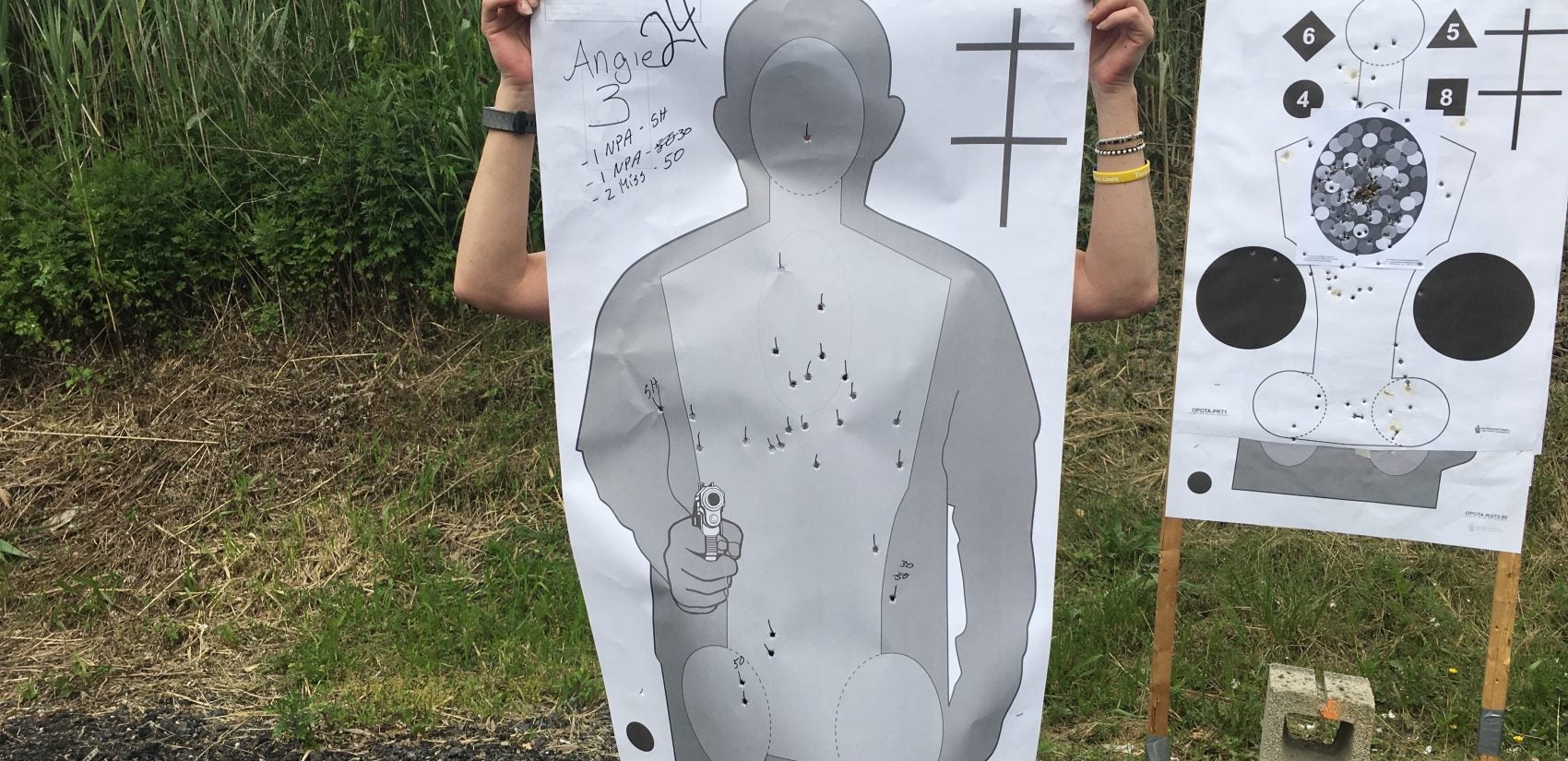
‘I can put faces to those dots’
To Angie, and scores of other Ohio teachers, arming educators is ordinary.
“Instantly, I liked it,” she said. “I know when it’s talked about, there’s a lot of controversy, ‘Oh, guns, school — it could go off, there could be accidents.’ I instantly was like, ‘Yes.’ I was all for it.”
Having never owned a gun, Angie signed up.
“Having the kids that are in my classroom and knowing that if there is a kind of threat, I’d want to protect them,” she said. “So I thought I’d take the training, and if I’m qualified…then we’ll make a decision if I’m a right fit.”
She agreed to spend three days of her summer vacation on a muggy firing range in Rittman, Ohio, just west of Akron, tucked behind railroad tracks and a salt factory.
When Eaton emailed directions to the place, he wrote, “I tell people, ‘If someone was taking me out there alone, I would be thinking they are not going to bring me back.’”
On the range, there’s a shed with rows of desks and a white board, and outside, eleven targets on wooden frames. At the start of the day, the targets are simple black ovals. As the hours pass, they’re replaced by human silhouettes.
From the start, Angie is attentive and chatty, comparing security plans with fellow teachers. She jokes that she’s brought an embarrassing amount of snacks. In the classroom, she has a polka dot bag jammed with sunscreen and bug spray. Angie’s school is footing most of the $1500 bill for the class, but she had to buy her own ammunition, and it’s sitting in a box on her desk next to a can of Diet Coke.
Of the 21 participants, Angie is one of the few from schools that already allow staff to carry. Another group are all from the same rural school district in Northwest Ohio. They include principals and assistant principals, middle and elementary school teachers, school resource officers and local cops. Their district doesn’t allow teachers to be armed — the superintendent is opposed — so one principal coordinated the training trip in hopes of changing her mind.
“I wanted to have something more than a baseball bat to go confront a possible AK[47] or a handgun or something like that. I knew I wanted to react and respond. I wanted to keep kids safe, but I wanted to have an option to do that that wasn’t just… myself, absorbing bullets,” said Chad, a high school principal who also asked not to have his last name printed.
Along with Andrew Blubagh, FASTER’s course is led by Chris Cerino, a Rittman police officer, firearms trainer, reality TV sharpshooting competitor, and former air marshal. He’s a towering presence, standing before the classroom in wraparound sunglasses, legs spread wide, arms crossed over his chest.
“We train everyone from army rangers to teachers,” Cerino tells the students. “The most likely to carry guns and the least likely to carry guns.”
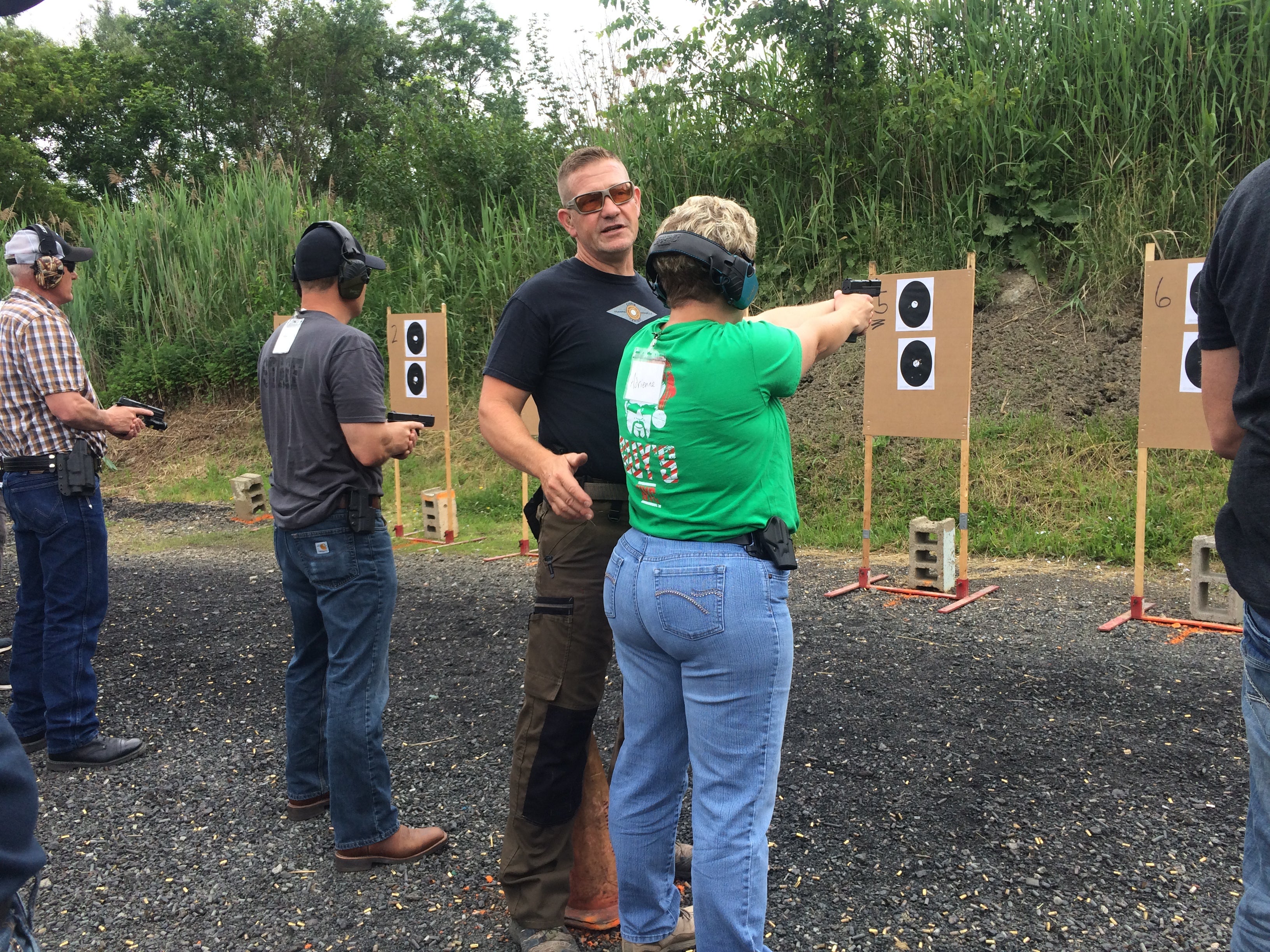
Cerino and Blubagh claim that by the end of the three days their students will have more active shooter training and be held to higher standards of target accuracy than police officers. It’s a major FASTER talking point, one that Eaton stressed when he visited Tamaqua. It’s also a controversial one — Tamaqua residents pushed back when school board president Larry Wittig repeated the claim, saying it does a disservice to law enforcement.
But there seems to be some credence to the claim. Ohio requires 60 hours of firearm training, but time spent on active shooter scenarios varies academy to academy. The state’s qualifying firearms test only requires officers to hit 21 targets out of 25, a passing rate of 84 percent.
In Pennsylvania, the minimum passing score is 75 percent.
FASTER requires participants to hit 26 out of 28, a passing rate of 92.8 percent.
The day starts with students practicing their aim using certification pistols, which fire lasers instead of bullets. Quickly, they move to practicing with real guns out on the range, learning to perfect their grip, to square their feet to the target, to hold position after firing.
Later, Cerino walks his students through a history of active shooter massacres, from the Austin Tower shooting in 1966 — when civilians helped police stop a gunman terrorizing the University of Texas — to the Parkland shooting.
Cerino plays a computer simulation of the Parkland attack produced by Fox News. An aerial view of the school’s layout is shown, with students and teachers and the gunman depicted as different colored dots, moving from classroom to classroom.
When the attacker’s gun is drawn, a black stick appears next to his dot. When he shoots a student, their dot changes from blue to yellow if they are injured — to purple if they die. The gunman’s dot hovers near classroom entrances, shooting through the doors’ narrow windows. Clusters of purple dots pile up, some of them students who died in their classrooms, others who died trapped in the hall.
Cerino points out every teacher that arrives on the scene. “Teacher,” he says, “not armed.”
Angie is moved by the demonstration. “Because we do that, we practice lockdowns and my kids are those symbolic little green dots hiding in the corner. I can put faces to those dots and names to those dots of my own students,” she says.
It steels her resolve.
***
Throughout the presentation, Cerino purposely avoids the word “shooting.” Although Parkland and every other mass casualty event he references was committed with a firearm, Cerino talks about “active killers” and “mass killings,” not “active shooters” or “mass shootings.”
“I don’t like to think of guns as a weapon,” Cerino tells his students.
Guns, though, are the raison d’existence of the Buckeye Firearms Association, the parent organization of FASTER. The association’s political action committee has successfully pushed for relaxed gun laws in Ohio and unseated gun control candidates in Ohio and other states. One BFA board member also serves on the NRA’s board of directors.
During the training session, Irvine, the president of the Buckeye Firearm Foundation and chairman of the Buckeye Firearms Association PAC, fields calls from a local reporter writing a story about a gun control proposal.
“This is bought and paid for by Bloomberg, tricking the misinformed voter,” Irvine tells the reporter. He was referring to former New York City Mayor Michael Bloomberg, who funds the group Everytown for Gun Safety.
“[Bloomberg] is ok with more kids dying,” he says.
Throughout the course, the instructors walk a fine line: On the one hand, they downplay guns’ destructive and deadly potential. On the other, they acknowledge that teachers are here to learn to kill.
FASTER builds its students up to see themselves as ‘the good guys.’ And as a good guy, the instructors repeat often, killing can be a humane act when innocent lives are at stake.
“Thou shalt not kill?” Blubagh says to the class. “No, though shalt not murder.”
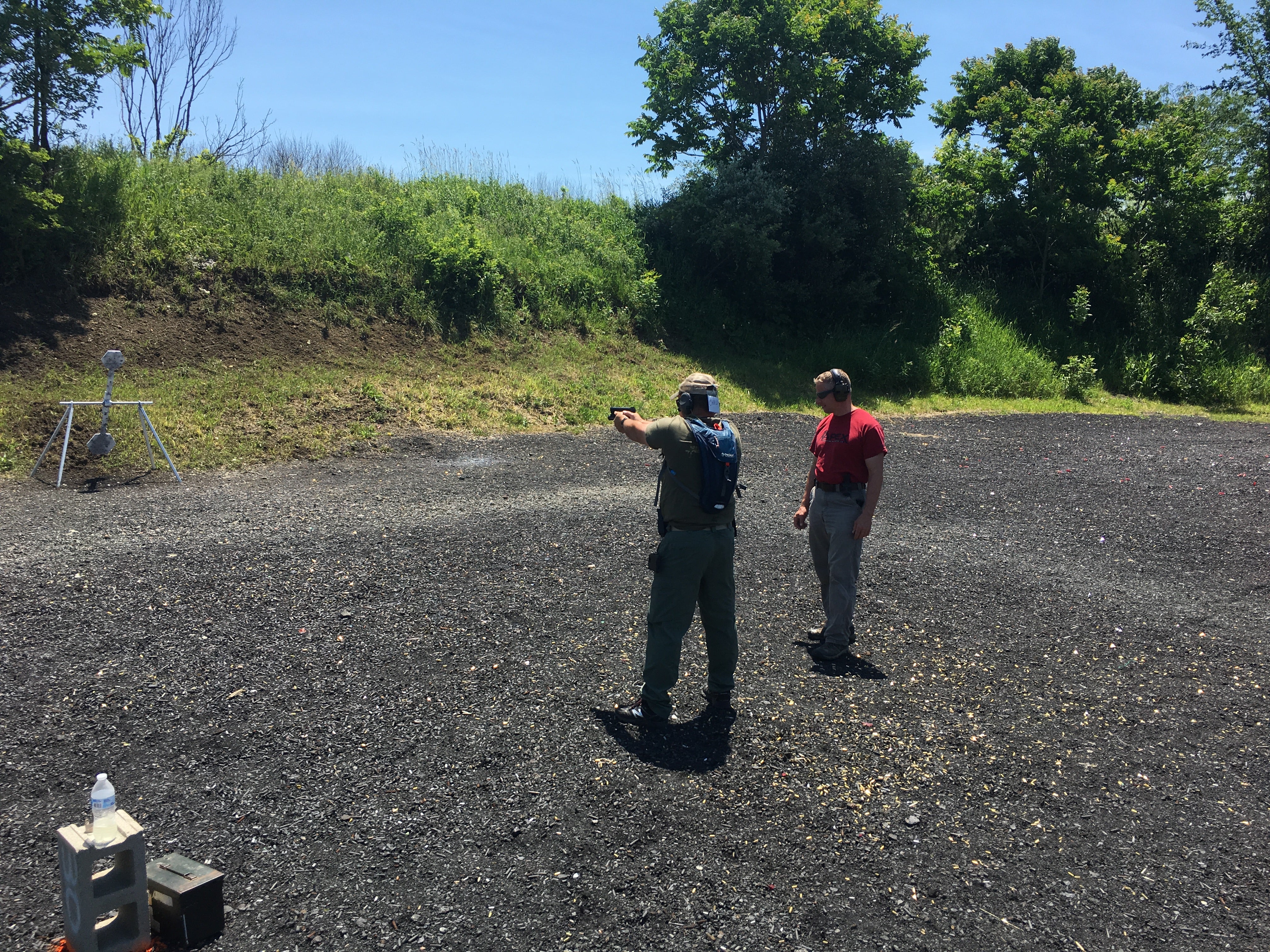
Irvine compares having guns in classrooms to being prepared with Epipens in case of allergy attacks or a defibrillator in case of heart trouble. Schools would be negligent not to have those tools on hand, he says.
“That is the power of the gun,” he says. “We call it ‘a piece.’ Why? Because it brings peace. It brings tranquility.”
FASTER has become increasingly popular with both teachers and state politicians. The state of Ohio recently granted the program $200,000.
But despite the growing clout of this and similar programs, there’s a void of convincing evidence that arming teachers makes students safer. According to the National Center for Education Statistics, nearly half of public schools in the U.S. have some form of armed law enforcement. And armed school resource officers have stopped shootings.
Yet studies have found that the presence of a gun-holding resource officer seems to have no effect on the likelihood or severity of an attack.
There has been at least one documented incident in which a school administrator used a gun to apprehend a shooter. After a gunman opened fire in a high school in Pearl, Mississippi in 1997, assistant principal Joel Myrick detained the suspect at gunpoint until police could arrive. In 2018, Myrick told the New York Times that he does not support arming school staff.
The gun control advocacy group Giffords has compiled a list of over 70 incidents of adults mishandling guns in schools in the past five years.
Earlier this summer, a janitor accidentally fired a weapon while cleaning it in his Wisconsin school, injuring a student. He was charged with illegally possessing a gun on school grounds, and two teachers were charged with failure to report child abuse or neglect. The teachers knew what had injured the child, but lied to her parents, and did not disclose the incident to authorities.
Last year, a Georgia teacher locked himself in his classroom and fired a bullet on purpose.
Irvine, however, believes that arming teachers will most certainly make students safer — so long as it’s part of a larger strategy. In an ideal scenario, he says, the gunman never gets to school.
FASTER does not focus on that.
“This is when that fails, and you’re here. That’s this class,” he said.
As a result, in FASTER’s program, there’s no talk about identifying possibly troubled students or about classroom management during a shooting. Aside from a brief presentation on how to conceal a gun, there’s no talk about the vast majority of the time that teachers would be in their classrooms, armed, without needing to fire their weapons.
During the course, Blubagh and Cerino recommend books like “The Gift of Fear,” and “On Killing: The Psychological Cost of Learning to Kill in War and Society.”
Only once, over the three day course, does an instructor acknowledge that it’s likely these teachers and school administrators could need to kill children — their own students.
In an interview later, Irvine gives the example of a teacher who has worked with a troubled student, gotten to know them deeply, and then witnesses that same student come back to their classroom with a gun.
Any teacher who goes through this training would need to ask themselves, “Do you have it in you to shoot that kid down?” he said.
Wenzel, and other teachers in Tamaqua, worry deeply about that moment, that decision. And they worry about the moments that come after. What happens tomorrow? Does the teacher keep their job? What supports exist for them?
Irvine has no direct answer.
Back on the range, Angie finishes her second day, completely exhausted. She practiced shooting at close range and long range, walking and standing still. She’s learned how to improvise a stretcher to carry an injured person, and how to tie a tourniquet.
But there’s one day left: scenarios. Tomorrow, she’ll practice in a real school.
***
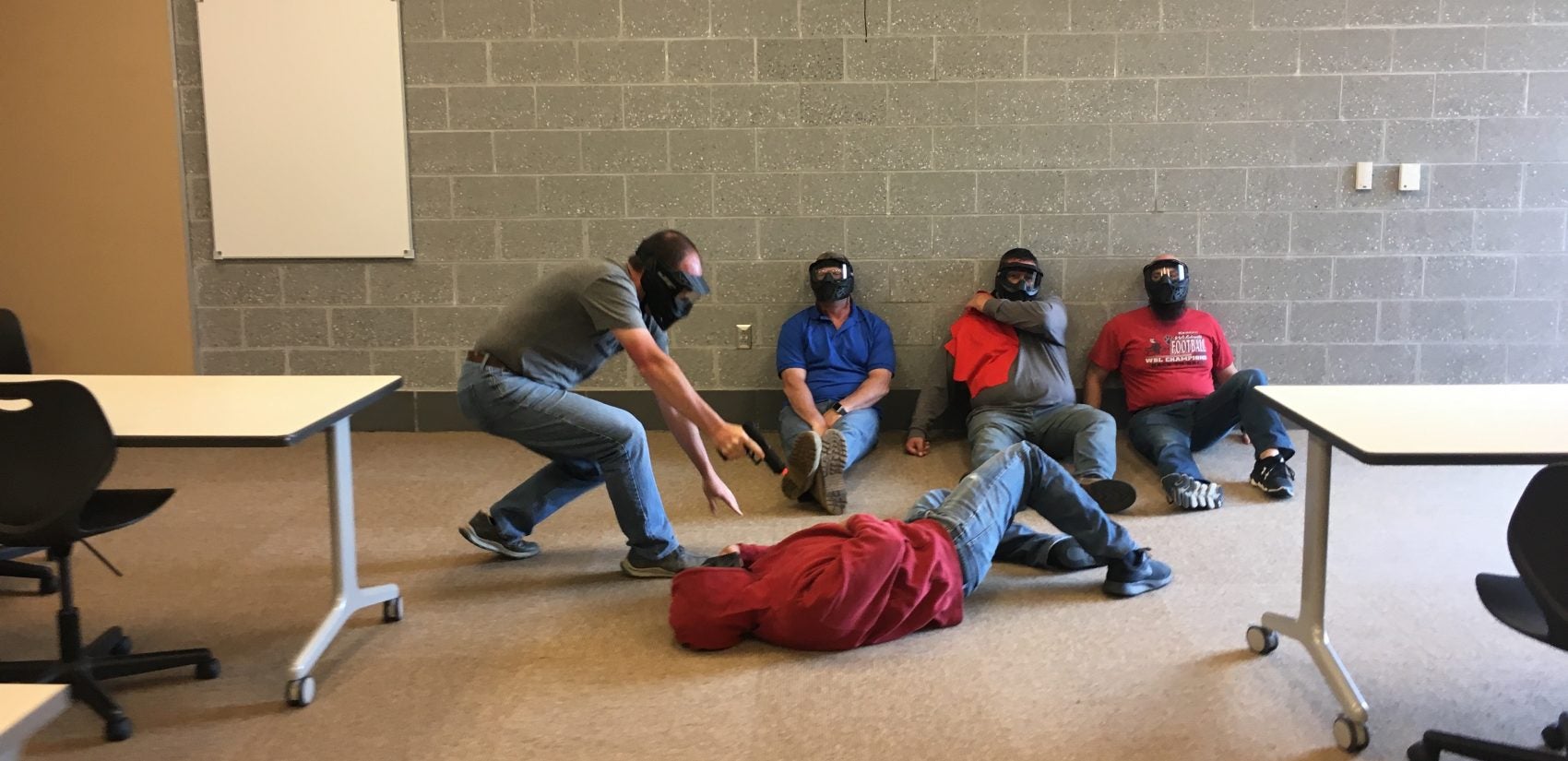
‘The heat of the moment’
A quick trip from the shooting range there’s a high school. Its hallways are empty and cavernous, lined with lockers that are mostly grey, occasionally bright red. Angie makes her way through them in wide arcs, sweeping each alcove to ensure no one is hiding before she moves to the next blind. She carries an airsoft gun — a replica weapon that shoots round plastic pellets and sounds like a real firearm — out in front of her, chest-high.
“It makes it more real, it does, to think this is why we’re training. This is what we’re doing this for,” she says.
She’s not nervous. As a teacher, she says she’s used to being vigilant and making sure everything runs smoothly.
“I feel like I do that kind of thing on a daily basis,” she says.“This is where I live, if you will.”
An announcement comes over the PA system at the school, where students are in summer school classes down the hall.
“You might hear some gunshots, screams, nothing to be alarmed about,” a female voice says. “It’s all just a safety measure and a drill.”
Angie is glad for the warning. She worries what students would think witnessing the training. “This is an image they can’t get out of their mind,” she said.
Across the country, the threat of shootings has already changed schools. Students have experienced real fear and anguish during lockdowns and drills, which they sometimes can’t distinguish from the real thing. Some teachers keep rooms locked during classes and cover their door windows. Some educators have laid painter’s tape on the floor to mark where students would be safe from gunfire.
During the simulation, Blubagh demonstrates simple door barricades that students at Wadsworth made in their shop classes, just for this purpose.
On this final day of the FASTER program, trainees take everything they’ve learned and bring it into the school environment. They learn how to lean around doorways so they won’t be seen, how to zig zag down a hallway, how to work the angles to see as much of a room as possible while still taking cover.
“Tactics is all about inches and angles,” Cerino mutters. “Sounds like a porno.”
Trainees run through four scenarios, alternating between playing victims, bystanders, and armed teachers.
Each scenario asks them to run through the hallways, seeking out a gunman. In a real shooting, Blubagh says teachers could also hide in wait at their classroom doors.
Angie says this is what she’d probably do. She has 45 fifth graders she wouldn’t want to abandon.
Each scenario asks the all important question: to shoot, or not to shoot?
In the first, Angie plays a victim, a square of red felt placed beside her head as a stand-in for pooling blood.
“Am I alive?” she chirps.
“No,” says Cerino.
Downstairs, another group of trainees waits to respond to the sound of gunfire. They have no idea what they will encounter. When gunshots go off, Angie thinks about how hard it is to tell where they’re coming from, echoing down the empty halls. She teaches acoustics to her 5th grade science students. This is just like that.
In the next scenario, she’s a responder. She’s corralled into a second floor teachers’ lounge, waiting as, one at a time, each trainee leaves to follow the sound of gunshots to the perpetrator. As the minutes tick by, Angie jokes, “This is probably the longest I’ve ever been in a break room.”
While she waits, she examines a wooden slat leaning against the wall, intended to block the door and keep out intruders. Angie says she could use it to bash someone over the head too.
“I have, by my bed at home — until I get my own gun — I have a Louisville Slugger. I have a box cutter. I have a screwdriver. I have a hammer. I have every type of object that could maybe slow somebody down,” she says. “Right within reach.”
A shot rings out. Finally, it’s Angie’s turn.
She makes her way down the hall, using what’s she’s learned — sweeping for movement and shadows. She comes upon a classroom with a victim laid out on the floor. A group of trainees acting as students gather around the dead body. A gun dangles limply from one student’s hand.
“What’s going on in here?” she shouts. “Let me see everyone’s hands.” Angie commands the student with the gun to put it down, and everyone else to take a seat. The bystanders obey. They role play as teenagers, trying to photograph the dead body on their phones. Once Angie has “called the police,” Cerino ends the scenario.
She made the right call: she didn’t shoot the student holding the gun.
It turns out, the perpetrator is sprawled out on the floor. She’d shot herself, right under a poster in this Spanish classroom that reads, “Te quiero hoy mas que ayer, pero no tanto como manana.”
Cerino asks Angie why she didn’t shoot.
“Because he wasn’t holding the gun in a threatening way toward her. And none of you seemed scared or endangered,” she said. “So I could just sense from your guy’s body language, from your reactions, that it was already done.”
“From the mouths of babes,” said Cerino. “That was perfect.”

In the next scenario, Angie does choose to shoot. She follows a trail of bloodied and dying victims down a long hallway, and then arrives at an alcove where the shooter stands, surrounded by bodies, gun to his own head.
Angie pauses. Maybe, she thinks, she should try to talk him off the ledge.
“But then I look and everyone is dead and he’s got the gun to his head, and it’s like, what’s the right choice right now?” she recalls later. She does what she’s been trained to do: she shoots to kill.
Afterwards, debriefing the scenario, she tells Blubagh she thought maybe she should have tried to deescalate instead.
“Shooting people is a deescalation technique,” Blubagh replies. “If someone comes in your school with a gun and they’ve murdered eight people, is shooting not deescalating the situation?”
***
What doesn’t come up until almost the very end is what happens if a teacher shoots the wrong person. What if they miss and hit a bystander, or if they react wrong and shoot an innocent person?
The question is broached as the last scenario is underway. Blubagh is frustrated because trainees keep making the same mistake: They keep giving verbal warnings before shooting.
In this scenario, an angry father is at the front of the classroom, threatening a teacher who has been sleeping with his daughter, a student.
“She’s pregnant!” the gunman is yelling. “I’m going to blow your brains out.” He waves his gun menacingly in the teacher’s direction, and fires a warning shot into the air.
Trainees keep bursting through the doorway yelling, “Hey!” or “Stop!” or “Drop the gun!” and Blubagh wants them to know they do not need to do this.
“Are you in fear for your life? Are you in fear for other people’s lives and safety? Is he allowed to have a gun in here? Is he allowed to fire shots?” Blubagh says.
If they can answer ‘yes’ to the first two questions and ‘no’ to the second pair, then they should feel confident to pull the trigger, says Blubagh, no questions asked.
He knows the teachers are worried about getting it wrong, worried about liability. So he gives them an example of a time that an innocent person was shot and killed and the perpetrators were not criminally charged.
It’s a shooting that he says was understandable, maybe even unavoidable: the 2014 killing of Tamir Rice, 12 years old, at the hands of Cleveland police.
“On the surface, they were right. They did what they had to do. They were in fear for their life,” Blubagh says.
The officer in that case, Timothy Loehmann, shot Rice at the city park where he was playing. Loehmann and another officer, Frank Garmback, had received an inaccurate report from dispatch, telling them that someone was waving a gun, when in fact the 911 caller had told dispatch they didn’t think the gun was real. The officers were white. Rice was black.
Video evidence showed that Loehmann shot Rice twice before the squad car stopped moving. A judge later wrote, “this court is still thunderstruck by how quickly this event turned deadly.” Rice, a sixth-grader, died the following day.
Police later determined Rice’s gun was an airsoft replica that lacked the orange tip indicating it was non-lethal.
Blubagh, speaking to a room of white educators in a classroom less than an hour from Cleveland, said the officers were reacting to the information in front of them.
“I’m not sticking up for them. I feel terrible for them, and I don’t know what I would do in that instance,” said Blubagh.
But, he continued, he thinks that given what they knew, those officers would probably make the same choice again.
“I’d be very hard-pressed to think any different — that they would look at that and say, ‘Man if I had to do that over, I’d do it different,’” said Blubagh. “They were going off what they’ve normally done, and been successful at it.”
“It just backfired on them in that instance,” he continued.
The officers were not criminally charged in Rice’s death. That’s why Blubagh is telling this story. To reassure his trainees. He knows they fear it would look bad if they just popped into this room and shot someone without yelling a warning, particularly if they turn out to have shot the wrong person.
“[But] if you can articulate your stuff — in the heat of the moment, in your shoes, in that time, you felt [the teacher in the scenario] was in imminent danger, you believed his life was threatened, if you didn’t do something that he’d hurt him and possibly everyone else,” Blubagh says, trailing off. “That’s what an investigation is about.”
***
‘Shooting like a teacher’
Later that day, it’s the trainees’ turn to shoot their qualifiers. The instructors staple up clean new targets in the shape of a human head and torso. Every trainee has to shoot 28 times — from 3 feet away, then 9 feet, then 12, 20, 30, shooting with their dominant hand and their less dominant hand, shooting while walking, shooting in the groin, the chest, the head.
To pass, they need at least 26 hits out of 28. A shot that misses the silhouette will lose them one point. A shot that misses the entire target knocks them down two. The margin for error is razor thin.
Angie has improved dramatically over two and a half days of practice, but her bullet holes are still spread scattershot across her target, not concentrated in the center. In the practice round, she misses the target completely three times.
“You’re shooting like a cop,” Cerino tells her. “Soon, we’ll have you shooting like a teacher.”
But despite the fact that the qualifier is looming, and she still hasn’t hit close to 26, Angie doesn’t seem nervous.
“Still not quite there, but it’s the best I’ve ever done,” she beams after a practice shoot. “I got the head! I’m proud of that.”
It won’t be enough to qualify, but Angie isn’t worried. It turns out her school doesn’t actually require her to pass this training in order to carry a gun in her classroom.
While FASTER boasts that their students are held to a higher standard than Ohio police officers — who only need to hit 21 targets out of 25, a passing rate of 84 percent — Angie’s school only requires her to hit 20 out of 28, a passing rate of 71 percent.
Even if she doesn’t do that, it’s ultimately up to her local school resource officer — who doubles as a history teacher in her district — to decide whether she can join.
“Our school, if they want us to do it, no matter what we get on this, we’ll do it,” she said.
When it’s her turn to qualify, Angie shoots better than she ever has: 22 shots hit their mark. It’s not enough to pass FASTER, but it’s good enough for her school.
She gets one more chance, a reshoot. It’s clear that the first round has buoyed her spirits. She waits with her hands on her hips, chest puffed out and high.
On the reshoot, she does even better: 24 out of 28. She rolls up the target to keep, as a memento.
“I’m pretty psyched about my 24. They wanted to see a 26, but for where I’m at with this practice, I’m happy,” she said. “It’s the best I’ve ever done.”
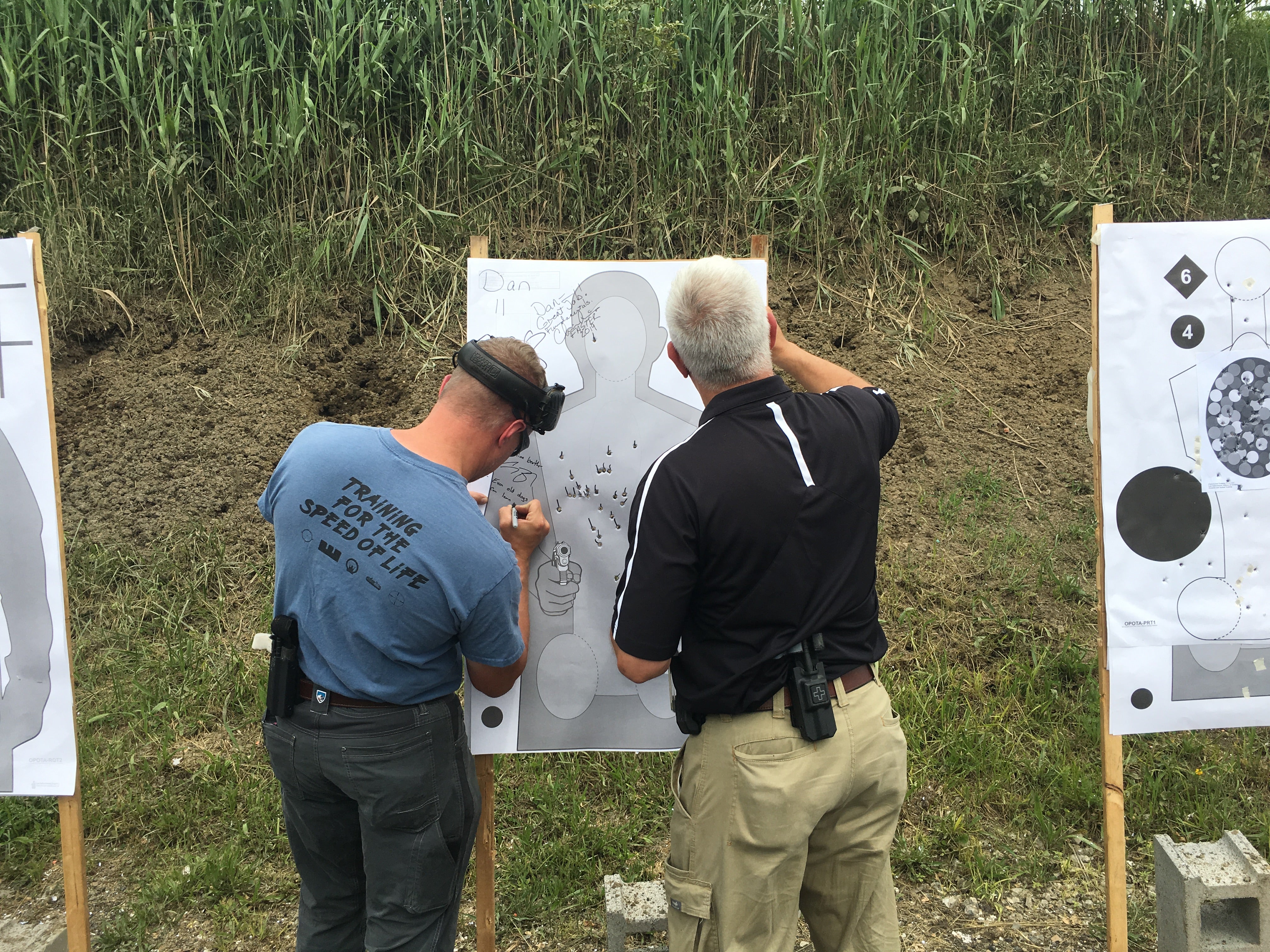
***
A few weeks after the training, Angie received her concealed carry permit and bought her first gun.
She began wearing it in public. A week before school started — a week after back-to-back mass shootings in Dayton and El Paso — Angie felt she would be ready if she found herself in the middle of an attack.
“If someone went and pulled out their gun and started shooting, I feel like I could protect the people around me, and myself,” she said.
Before classes started, Angie and other staff went to the firing range with their school’s security officer. Angie hadn’t yet been approved to carry in the classroom, but after FASTER, the officer told her she seemed confident.
“Just a little more time, they will make me active in the school,” she said.
Angie wishes that time were now.
“I wish I had it with me,” she said. “I want to be prepared.”
—
Additional reporting and field production by Chris Seigel.
Correction: This article has been updated to include details of a school administrator using a gun to detain a would-be shooter in 1997.
WHYY is your source for fact-based, in-depth journalism and information. As a nonprofit organization, we rely on financial support from readers like you. Please give today.



